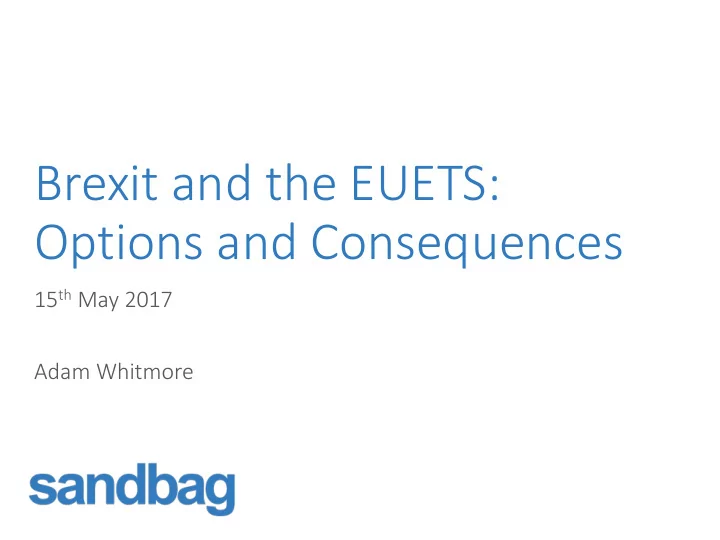

Brexit and the EUETS: Options and Consequences 15 th May 2017 Adam Whitmore
There is a range of options for the UK’s relationship with the EUETS 1. UK remains part of the scheme 2. Linking remaining close to full membership, UK scheme uses EUAs (“EEA model”) Increasing 3. Linking with a UK emissions trading system (“Switzerland separation model”) from the 4. One way linkage: Allowing EUAs as compliance in a UK carbon EUETS pricing scheme up to a limited percentage (“Australian model” – not implemented) 5. One-way linkage, but restricted to certain sectors (e.g. those on carbon leakage list) 6. Complete separation • It is desirable that arrangements take effect when Phase 3 finishes at the end of 2020, so short term (approximately 2 year) transitional arrangements will be required. 1
Under most options the EU will need a new cap that excludes the UK • We assume that EU27 + EEA 2005 base year emissions are subject to the same percentage reductions as under the current cap (which includes the UK) • Removing only the UK allocation from the cap would lead to lower percentage reductions for the EU27, and would not be consistent with 2014 Council Conclusions 2377 2500 -23.6% -43.3% 2000 1815 1500 MT CO2e 1332 1000 500 0 2005 2020 2030 EU 27 UK EEA 2
This leads to a net tightening of the cap, as UK emissions are below its “share” of 2005 Net tightening of 745 million tonnes 300 over Phase 4 (about 5%) 250 200 Mt CO2e stationary 150 100 50 0 -50 2008 2009 2010 2011 2012 2013 2014 2015 2016 2017 2018 2019 2020 2021 2022 2023 2024 2025 2026 2027 2028 2029 2030 UK Balance Offsets Emissions Notional Cap • Cap is notional share of total cap not the UK’s current allocation 3
However this will make little difference to the supply-demand balance in 2030 • Much of the additional surplus available with the UK as part of the scheme is swept up by the MSR and eventually cancelled (or remains in the MSR if no cancellation) • Consequently the supply demand balance is less different than the additional scarcity initially suggests by the time the market returns to shortage. 4
There is an opportunity for the UK to develop leading practice • UK framework of carbon budgets leading to a 2050 target (all legally binding) remains leading practice • Opportunity to deliver this with a suite of policies including • Initial reform of CCL and CPS • A well-designed UK ETS with wide scope and a floor price • Complementary policies in areas such as energy efficiency and system transformation • Potential future linkage • Linkage to the EUETS should be avoided or strictly limited while the system is in surplus • The combination would be unique and could provide a model for other economies • California is closest 5
A UK ETS would not be exceptionally small compared with other systems 6
There will be a need to reconsider accounting for carbon budgets • Accounting will need to change if there is no UK budget • Should desirably change even if the UK stays in the EUETS • Or risk of meeting carbon budgets through “buying hot air” 300 250 200 MT CO2e stationary 150 100 50 0 2005 2006 2007 2008 2009 2010 2011 2012 2013 2014 2015 2016 2017 2018 2019 2020 2021 2022 2023 2024 2025 2026 2027 2028 2029 2030 Emissions Low emissions Actual UK supply 7
Effects on international markets of any UK departure depends on both actions and perceptions • Will there be a negative perception of UK departure? • Fragmentation of carbon markets • Or will it be regarded as natural? • Governed by the wider Brexit picture • Leaving an ineffective mechanism • Will there be a positive perception from renewed UK policy innovation? • Another example of well-designed carbon pricing? • Including linkage outside the EU providing a model? • Linking of carbon budgets with a wide cap could be best practice? • Other UK policy innovation? • Could EU response to the UK departure enhance credibility 8
Conclusions • Small positive effect on EUETS supply/demand from UK separation, but essential that: • Cap is adjusted to maintain percentage reductions for EU27 • EU ETS reform continues, including cancellations from MSR, and is strengthened • Benefits for UK of any departure depend on good policy design • Essential that progress towards carbon budgets is maintained • Linkage with EU ETS should be conditional on no surplus (except perhaps limited one way linkage) • Linking with other schemes may offer other opportunities • Changing accounting under the Climate Change Act both necessary if the UK leaves the EU ETS and desirable in any case • Departure aligns jurisdiction of targets and policy instruments (UK or EU instruments for UK or EU targets) so all need to be effective 9
Recommend
More recommend